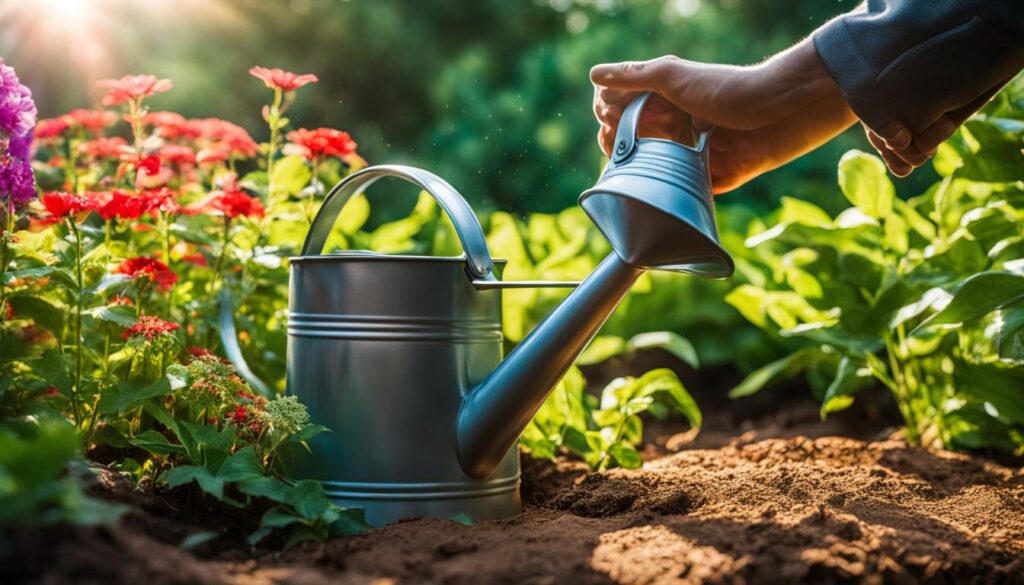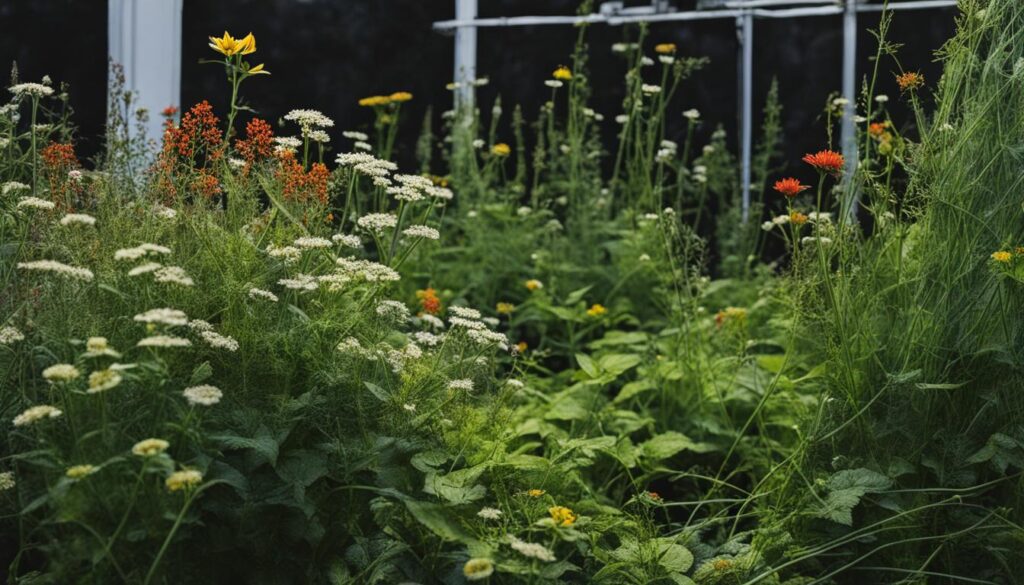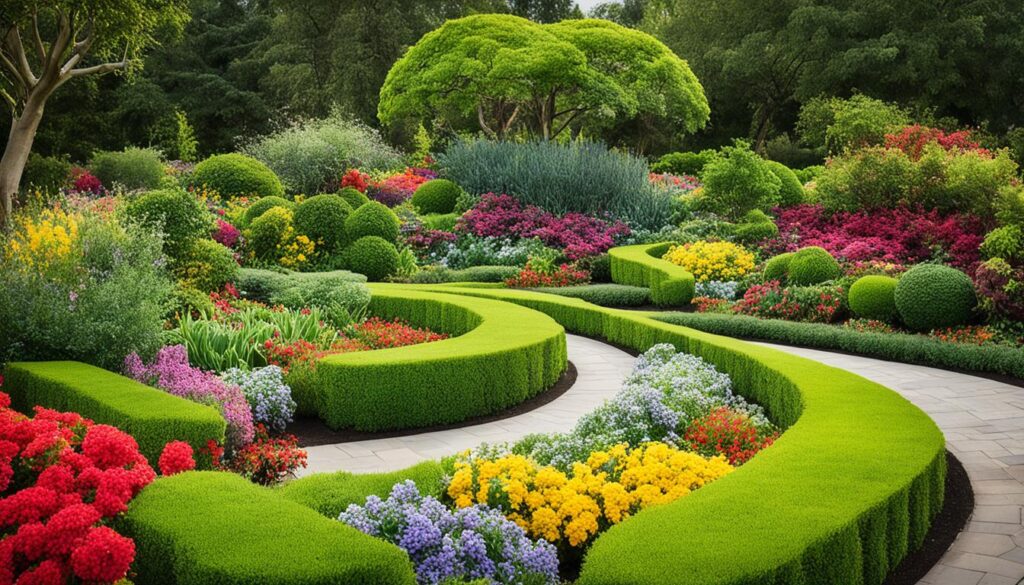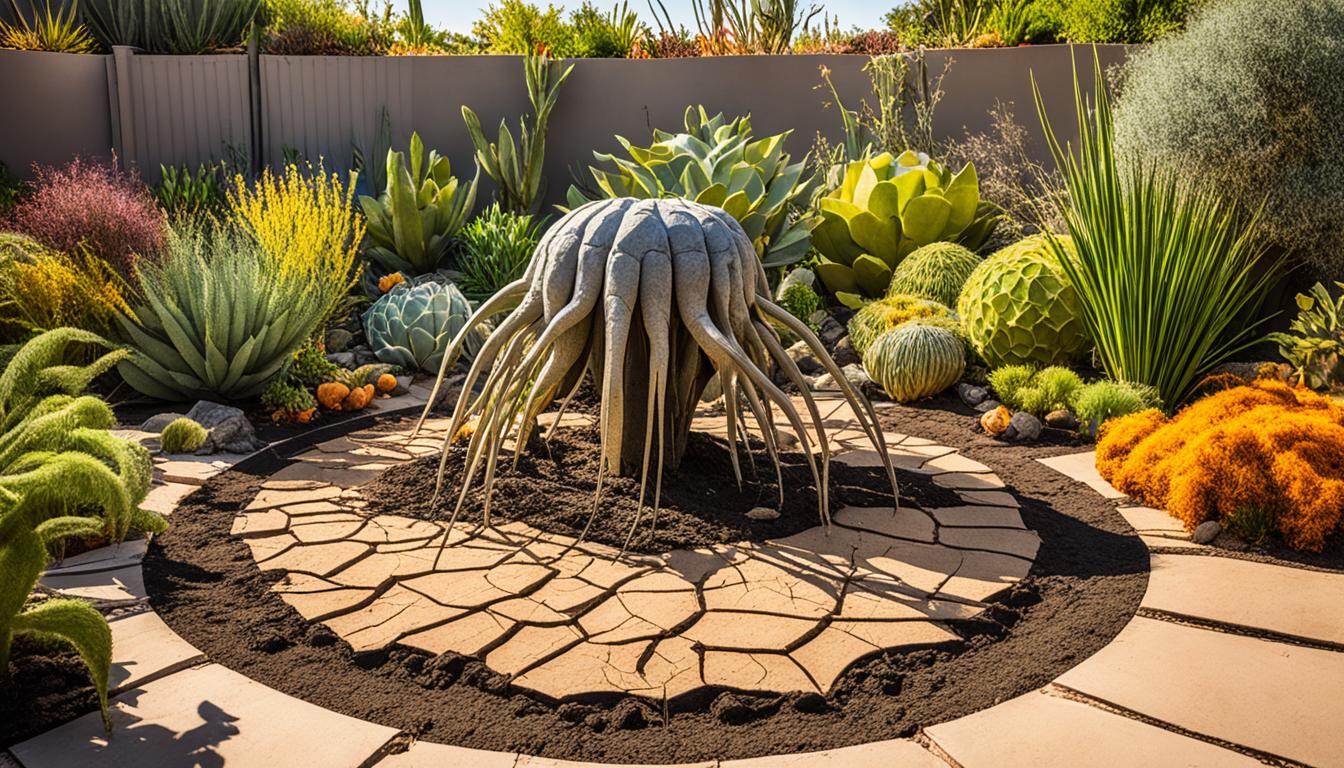Hello, fellow garden enthusiasts! Are you tired of hearing conflicting advice about how to create a flourishing garden? Well, you’re not alone. There are many gardening myths out there that have been passed down through generations, but it’s time to set the record straight. In this article, we will debunk some common gardening myths and provide you with the truth behind them. So, let’s get started and separate fact from fiction to help you achieve the garden of your dreams.
Key Takeaways:
- Not all gardens need to be south-facing. Woodland planting can thrive in cooler, shaded environments.
- Pampas grass is not a symbol of a saucy household. It was simply popular in the 1970s.
- Cacti still require regular watering and fertilization despite their drought-tolerant nature.
- Watering plants in the sun is not always a bad idea. It’s better to water in the morning or evening to avoid wilting.
- Some weeds are beautiful and wildlife-friendly, making them welcome additions to your garden.
South-facing gardens are best
When it comes to gardening, south-facing gardens have traditionally been thought of as the ideal option. But as our climate continues to warm, it’s time to reconsider this notion. Cooler, shade-filled environments are becoming increasingly attractive for plant growth and can offer unique opportunities for beautiful and thriving gardens.
One popular approach to creating lush and vibrant gardens in shaded areas is woodland planting. This style of gardening incorporates plants that are naturally adapted to thrive in cooler and shadier conditions. Some great examples of plants for woodland planting include:
- Digitalis purpurea (foxglove)
- Polypodium cambricum (creeping fern)
- Eurybia divaricata (white wood aster)
- Brunnera macrophylla (siberian bugloss)
- Tiarella cordifolia (foam flower)
- Viburnum tinus (French white shrub)
- Geranium psilostemon (Armenian cranesbill)
- Astrantia major ‘Ruby Star’
Woodland planting can add depth, texture, and a touch of wild beauty to your garden. These plants are specifically chosen for their ability to thrive in shade and their resistance to pests and diseases commonly found in sunnier areas. Plus, they create a tranquil and serene atmosphere that can be enjoyed year-round.
To truly appreciate the beauty of woodland planting, take a moment to imagine it in action. Picture a secluded corner of your garden, with streams of dappled sunlight filtering through the trees. The Digitalis purpurea towering over the undergrowth, its tall spires adorned with delicate purple flowers. The Brunnera macrophylla leaves shimmering in shades of silver, providing a striking contrast against the dark green ferns. And the Geranium psilostemon and Astrantia major ‘Ruby Star’ bursting forth with vibrant colors, attracting bees and butterflies.
Woodland planting brings a sense of enchantment and tranquility to any garden. By embracing the natural beauty of shade-loving plants, you can create a captivating oasis that will delight your senses and provide a haven for wildlife.
So, if you have a shady spot in your garden, don’t despair. Embrace the opportunity to explore the world of woodland planting and create a garden that is both stunning and sustainable. With the right choice of shade-loving plants, you can transform your south-facing garden into a lush and vibrant haven that will be the envy of all.
Pampas grass is for swingers
Contrary to popular belief, pampas grass does not indicate a saucy or swinger household. This myth likely originated from the plant’s popularity among the middle class in the 1970s. Pampas grass, specifically Cortaderia richardii, is an elegant and visually appealing species that can be a great addition to any garden.
“Pampas grass adds a touch of grace and beauty to any garden. It’s the perfect foliage to create a stunning landscape while attracting the attention of passersby.”
You Can’t Ignore Cacti
Contrary to popular belief, cacti are not plants that can be ignored. While they are indeed resilient and have the ability to survive in harsh conditions, they still require proper care and attention to thrive. This includes regular watering and fertilization, especially during their growing season.
Like all plants, cacti need water to survive and grow. While they can withstand drought and go without water for extended periods, it is crucial to provide them with adequate moisture. However, it’s important to strike the right balance and avoid overwatering, as cacti are susceptible to root rot.
When it comes to fertilizing cacti, they respond well to diluted fertilizers specifically formulated for cacti and succulents. These fertilizers provide the necessary nutrients for healthy growth, but it’s crucial not to overdo it. Over-fertilizing can lead to excessive growth and weaken the overall structure of the cactus.
Additionally, cacti require sufficient sunlight to thrive. Placing them in a sunny location where they can receive at least six hours of sunlight per day is essential. This will enable them to carry out photosynthesis and maintain their vibrant colors.
In conclusion, while cacti are known for their ability to withstand challenging conditions, they still require adequate care. Regular watering, proper fertilization, and sufficient sunlight are essential for their overall health and growth. By providing these necessary elements, you can ensure that your cacti thrive in your garden or indoor space.

| Watering Tips for Cacti | Fertilizing Tips for Cacti |
|---|---|
|
|
Never water when the sun’s out
Many gardeners believe that watering plants in the sun can lead to wilting or faster drying out. While it is true that water evaporates more quickly in direct sunlight, there are still guidelines to follow for effective watering.
The best time to water plants is in the morning or evening when the sun is less intense. This allows the plants to absorb the water before it evaporates. However, if watering during the day is unavoidable, it is still better to water than to not water at all. The key is to water deeply so that the water reaches the roots.
Watering deeply ensures that the water penetrates the soil and reaches the root zone where it is needed the most. Shallow watering only wets the surface, leading to shallow root growth and increased susceptibility to drought.
To determine if your plants need watering, check the soil moisture by sticking your finger about an inch into the soil. If it feels dry, it’s time to water. However, if it feels damp, hold off on watering to prevent overwatering and potential root rot.

Weeds: More Than Just Nuisances in Your Garden
When it comes to gardening, weeds are often seen as a hassle and a problem that needs to be eliminated. However, it’s time to change that perspective. Believe it or not, some weeds can actually be beneficial and add beauty to your garden. Let me introduce you to a few examples.
1. Centaurea nigra (Knapweed)
Centaurea nigra, also known as knapweed, may be considered a weed, but it’s a stunning one. With its vibrant purple flowers and fern-like foliage, knapweed can add a touch of elegance to any garden. It’s not just about looks either – this wild plant is drought-tolerant and attracts important beneficial insects like bees and butterflies.
2. Leucanthemum vulgare (Ox-eye Daisy)
The ox-eye daisy, or Leucanthemum vulgare, is another misunderstood weed. With its cheerful yellow and white petals, it can brighten up your garden and provide a natural meadow-like feel. Moreover, ox-eye daisies are loved by pollinators, making them an excellent choice for supporting biodiversity in your outdoor space.
3. Achillea millefolium (Common Yarrow)
Achillea millefolium, commonly known as common yarrow, may be considered a weed, but its delicate white flowers and feathery leaves make it a captivating addition to any garden. This wild plant is not only drought-tolerant but is also a magnet for butterflies and other pollinators, supporting the overall health of your garden ecosystem.
If you’re still not convinced about the value of these “weeds,” consider their low-maintenance nature. These wild plants have adapted to survive in various conditions, making them hardy and easy to grow. Additionally, they can act as ground cover, suppressing the growth of other unwanted plants and reducing the need for excessive weeding.
So, the next time you spot these weeds in your garden, think twice before reaching for the weed killer. Embrace their beauty, support pollinators, and enjoy a more diverse and lively garden.
| Weed | Description | Benefits |
|---|---|---|
| Centaurea nigra (Knapweed) | Vibrant purple flowers with fern-like foliage | Drought-tolerant, attracts bees and butterflies |
| Leucanthemum vulgare (Ox-eye Daisy) | Cheerful yellow and white petals | Supports pollinators, adds a natural meadow-like feel |
| Achillea millefolium (Common Yarrow) | Delicate white flowers with feathery leaves | Drought-tolerant, attracts butterflies and pollinators |
Remember, not all weeds are created equal. By embracing these wild plants, you’re not only enhancing the beauty of your garden but also contributing to the health of the environment.

Lawns are low maintenance
When it comes to maintaining a beautiful lawn, many people assume that it requires minimal effort. However, the truth is that lawns actually require regular cutting and maintenance, especially during the spring and summer months.
One strategy to reduce the workload is to let the lawn grow a bit longer between cuts. This not only saves time but also allows the grass to develop stronger roots, making it more resistant to drought and weeds.
Another misconception is that all weeds should be eliminated from the lawn. In reality, leaving some weeds can be beneficial, as they provide food and habitat for insects like bees and butterflies. It’s all about finding a balance between a neat appearance and supporting biodiversity.
If you’re looking for a low-maintenance alternative to a traditional lawn, consider a two-cut-a-year meadow or low-maintenance ornamental planting. These options not only require less frequent mowing but also offer a more natural and diverse landscape.
Here’s a comparison between traditional lawns, two-cut-a-year meadows, and low-maintenance ornamental planting:
| Aspect | Traditional Lawn | Two-Cut-a-Year Meadow | Low-Maintenance Ornamental Planting |
|---|---|---|---|
| Maintenance | Regular cutting and weeding | Two cuts per year | Minimal maintenance |
| Watering | Regular watering | Less watering required | Minimal watering |
| Biodiversity | Limited biodiversity | Supports biodiversity | Enhances biodiversity |
| Aesthetics | Uniform green appearance | Natural meadow with seasonal blooms | Diverse mix of flowering plants |
In the image below, you can see an example of a beautiful low-maintenance ornamental planting:

By considering alternatives to traditional lawns and exploring low-maintenance options like two-cut-a-year meadows or ornamental plantings, you can create a visually appealing and environmentally friendly landscape with less effort.
Growing in Pots is Easier than the Ground
When it comes to gardening, many people assume that growing plants in pots and containers is easier and more convenient than planting them directly in the ground. While pots can offer better control over weed growth and are visually appealing, they do require more attention and care to ensure the health and vitality of your plants.
Growing plants in pots and containers comes with its own set of challenges. Here are some key considerations to keep in mind:
- Regular Fertilizing: Potted plants rely on the nutrients within the potting mix, which can deplete over time. To keep your plants healthy and thriving, it’s important to regularly fertilize them to replenish these essential nutrients.
- Frequent Watering: Unlike plants in the ground that can access moisture from the soil, potted plants rely solely on the water provided to them. This means they often require more frequent watering, particularly during hot and dry spells.
- Repotting and Adding Compost: As potted plants grow, their roots can become cramped and restricted within the container. Regular repotting and adding compost can help provide them with the necessary space and nutrients to flourish.
On the other hand, plants grown directly in the ground have the advantage of unlimited root space and a more stable environment. They can tap into the natural resources of the surrounding soil and establish a stronger root system, which often leads to healthier and more robust growth.
To control weeds in pots, planting more densely can help minimize bare soil where weeds can take root. By selecting plants that naturally spread and have dense foliage, you can create a living barrier that suppresses weed growth. Additionally, applying a layer of mulch or gravel on the surface of the potting mix can further deter weeds from sprouting.
Ultimately, whether you choose to grow plants in pots or in the ground depends on your gardening preferences and circumstances. Both methods have their advantages and challenges, so it’s essential to consider factors such as available space, plant varieties, and your level of commitment to maintenance.
Remember, gardening is a personal journey, and finding the right approach for your plants and lifestyle may require some experimentation. The key is to enjoy the process and nurture your green companions with care.
My Experience: Growing Herbs in Containers
One of my favorite gardening projects was growing herbs in containers on my apartment balcony. Despite limited space, I was able to cultivate a thriving herb garden that provided me with fresh flavors year-round.
“Growing herbs in pots allowed me to have easy access to fresh culinary delights. Whether it was snipping some basil leaves for a Caprese salad or harvesting fresh mint for a refreshing homemade mojito, having my own herb garden added an extra level of joy and convenience to my cooking.”
I carefully selected a variety of herbs such as basil, thyme, rosemary, and parsley, each in its own container. This arrangement not only made it easier to manage individual watering and care needs but also created an aesthetically pleasing mini-garden on my balcony.
To control weed growth, I opted for a thick layer of mulch made from shredded leaves. This not only prevented weeds from taking over but also helped retain moisture in the pots, reducing the frequency of watering.
Overall, my experience of growing herbs in containers was both rewarding and manageable. It allowed me to embrace the joys of gardening despite limited space, and I highly recommend it to anyone looking to add a green touch to their urban living.
| Pros of Growing in Pots | Cons of Growing in Pots |
|---|---|
| Pots provide better control over weed growth | Regular fertilizing is necessary to replenish nutrients |
| Potted plants can be aesthetically pleasing and add versatility to your garden | Potted plants require more frequent watering |
| Easy to manage and rearrange plants | Repotting and adding compost are essential to prevent root restriction |
| Great option for urban gardens or small spaces | Plants may be more susceptible to temperature fluctuations in extreme weather conditions |
In conclusion, growing plants in pots and containers can provide a convenient and visually appealing way to garden. However, it’s important to understand the extra care and attention they require, such as regular fertilizing, frequent watering, and the need for repotting. By weighing the pros and cons, you can make an informed decision about whether growing in pots or on the ground is the best option for you.
Raised beds are essential for veg
When it comes to growing vegetables, raised beds have long been hailed as a necessary tool for success. However, the truth is that raised beds are not always essential. While they do offer some advantages, it’s important to consider other factors before committing to raised bed gardening.
One of the main benefits of raised beds is improved drainage. The elevated soil level allows excess water to drain more efficiently, preventing waterlogged roots and promoting healthier plant growth. Additionally, raised beds can provide easier access for gardeners with mobility issues, minimizing the need for bending or kneeling.
But raised beds come with their own set of challenges. Slugs, for example, are notorious pests that are attracted to the moist environment created by the raised soil level. This can result in increased slug activity and potential damage to your vegetables. Additionally, raised beds may dry out faster due to their elevated position, requiring more frequent watering to maintain adequate soil moisture levels.
That being said, if you specifically need the height of raised beds for accessibility purposes or to elevate your plants from waterlogged soil, they can be a great solution. However, if these factors are not a concern for you, beds at ground level can be just as effective for growing vegetables.
Ultimately, the decision to use raised beds or traditional ground-level beds depends on your specific needs and preferences. Consider factors such as drainage, accessibility, pest control, and watering requirements when choosing the best option for your vegetable garden.
Raised Beds vs. Ground-Level Beds Comparison
| Factors | Raised Beds | Ground-Level Beds |
|---|---|---|
| Drainage | Improved drainage due to elevated soil level | Drainage depends on soil composition and slope |
| Accessibility | Easier access for gardeners with mobility issues | May require bending or kneeling; not ideal for those with mobility issues |
| Slug Attraction | Can attract slugs due to moist environment | Slugs may be less attracted due to ground-level position |
| Watering Requirements | May dry out faster and require more frequent watering | Watering requirements depend on soil composition and weather conditions |
Although raised beds offer benefits such as improved drainage and accessibility, they are not always necessary for growing vegetables. Consider factors like slug attraction, watering requirements, and personal preference when deciding between raised beds and ground-level beds for your garden.
Soapy water gets rid of aphids
Aphids can be a common problem in gardens, causing damage to plants and hindering their growth. While many believe that soapy water is an effective solution for aphid control, there are some important considerations to keep in mind.
Soapy water can indeed suffocate aphids by blocking their breathing openings. However, achieving the right mix of soap and water can be challenging, and using excessive amounts of soap can potentially harm your plants. The chemicals present in the soap may affect plant growth and cause damage if used in high concentrations.
Alternatively, you can manually remove aphids by gently rubbing them off with your fingers or spraying them off with water. This physical removal method can be highly effective, especially for smaller infestations. It is important to check the back of leaves and stems where aphids often congregate.
If you have houseplants, taking them outside can attract natural predators that can help control aphid populations. Hoverflies and ladybirds are beneficial insects that feed on aphids. These natural predators are attracted to the scent of aphids and can provide effective aphid control.
Here’s a brief table summarizing the advantages and disadvantages of different aphid control methods:
| Aphid Control Method | Advantages | Disadvantages |
|---|---|---|
| Soapy water | – Removes aphids through suffocation – Cost-effective |
– Difficult to achieve the right soap-to-water ratio – Chemicals in soap may harm plants |
| Manual removal | – Effective for smaller infestations – Targets specific aphids – No chemical exposure to plants |
– Time-consuming – Can be challenging for larger infestations |
| Natural predators (hoverflies, ladybirds) | – Provides ongoing aphid control – No chemical exposure to plants – Attracts beneficial insects to your garden |
– May take time for predators to establish – Predators may not completely eliminate all aphids |
Remember, it’s essential to monitor your garden regularly for aphid infestations and take appropriate measures to control their populations before they cause significant damage. By understanding different aphid control methods and utilizing them effectively, you can maintain a healthy and thriving garden.
Conclusion
As we conclude our exploration of gardening myths, it becomes evident that debunking these misconceptions is crucial for creating a thriving garden. Many long-standing beliefs have been perpetuated without factual evidence, leading to incorrect practices that can hinder the success of our plants.
By delving into the truth behind these myths, we empower ourselves as gardeners to make informed decisions and provide the best care for our beloved plants. As gardening techniques and practices continue to evolve, it is vital to stay updated and rely on reliable sources of information to ensure the health and vitality of our gardens.
So remember, let’s challenge those garden myths and embrace a new mindset based on knowledge and evidence. Together, we can create beautiful, flourishing gardens that defy the limitations of outdated beliefs.
FAQ
Are south-facing gardens still considered the best option for a successful garden?
In our warming climate, cooler, shade-filled environments are becoming more appealing. Woodland planting, with plants such as Digitalis purpurea (foxglove) and Polypodium cambricum (creeping fern), can thrive in these conditions.
What plants can thrive in a woodland planting?
Some plants that can thrive in woodland environments include Digitalis purpurea (foxglove), Polypodium cambricum (creeping fern), Eurybia divaricata (white wood aster), Brunnera macrophylla (siberian bugloss), Tiarella cordifolia (foam flower), and Viburnum tinus (French white shrub).
Does pampas grass signify a saucy household?
No, pampas grass was simply popular among the middle class in the 1970s and does not indicate a saucy or swinger household.
Can cacti be completely ignored?
While cacti are drought-tolerant and can survive without water for months, they still require regular watering and fertilization during their growing season.
Is it true that you should never water plants when the sun is out?
While water evaporates faster in the sun, it’s better to water in the morning or evening to avoid wilting. However, watering during the day is still better than not watering at all.
Are weeds always a nuisance?
Many wild plants that we consider weeds are actually beautiful and wildlife-friendly. Some examples include Centaurea nigra (knapweed), Leucanthemum vulgare (ox-eye daisy), and Achillea millefolium (common yarrow).
Are lawns low-maintenance?
No, lawns require regular cutting and maintenance, especially during the spring and summer months. Letting the lawn grow a bit longer with fewer cuts and leaving some weeds can help reduce maintenance workload.
Are plants easier to grow in pots?
While growing plants in pots may seem easier, they actually require more watering and fertilizing compared to plants in the ground. Weed control can also be more challenging in pots.
Are raised beds essential for growing vegetables?
Raised beds are not always necessary for growing vegetables. While they can provide better drainage and accessibility, they can also attract slugs and dry out faster. Planting directly in the ground can be just as effective.
Does soapy water get rid of aphids?
While soapy water can suffocate aphids, it’s better to remove them manually or attract their natural predators like hoverflies and ladybirds.
What are the benefits of debunking gardening myths?
Debunking gardening myths is essential for ensuring a flourishing garden. By understanding the truth behind these myths, gardeners can make informed decisions and provide the best care for their plants.

